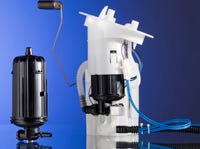Nanotube technology stops sparks
Standards set by the Society of Automotive Engineers (SAE) recommend a maximum specific volume resistance for materials used in applications that come in contact with fuel, and thanks to carbon nanotube additives in BASF’s (Ludwigshafen, Germany) polyoxymethylene (POM) Ultraform N2320 C, the material is 30,000 times more conductive than necessary, while maintaining toughness.
May 7, 2009
 Standards set by the Society of Automotive Engineers (SAE) recommend a maximum specific volume resistance for materials used in applications that come in contact with fuel, and thanks to carbon nanotube additives in BASF’s (Ludwigshafen, Germany) polyoxymethylene (POM) Ultraform N2320 C, the material is 30,000 times more conductive than necessary, while maintaining toughness. This material retains properties typical to POM, such as dimensional stability, toughness, and elastic resilience, and is actually stronger and more creep-resistant than conventional POM when the nanotube-filled grade comes into contact with fuel. The carbon nanotubes are firmly fixed in the plastic matrix so the material can be handled safely throughout its lifetime, making it ideal for use in electronic components in cleanroom conditions that require the absence of dust.
Standards set by the Society of Automotive Engineers (SAE) recommend a maximum specific volume resistance for materials used in applications that come in contact with fuel, and thanks to carbon nanotube additives in BASF’s (Ludwigshafen, Germany) polyoxymethylene (POM) Ultraform N2320 C, the material is 30,000 times more conductive than necessary, while maintaining toughness. This material retains properties typical to POM, such as dimensional stability, toughness, and elastic resilience, and is actually stronger and more creep-resistant than conventional POM when the nanotube-filled grade comes into contact with fuel. The carbon nanotubes are firmly fixed in the plastic matrix so the material can be handled safely throughout its lifetime, making it ideal for use in electronic components in cleanroom conditions that require the absence of dust.
BASF optimized this grade in a collaborative effort with Bosch for use in fuel filter housings for the Audi A4 and A5, which are being molded in Budweis, Czech Republic. Ultraform N2320C is said to be less costly than other conductive plastics and is available in commercial quantities globally. —[email protected]
About the Author(s)
You May Also Like


